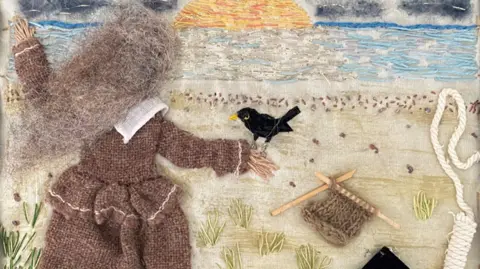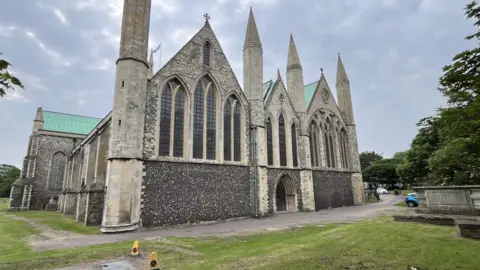Pilgrimage remembers women condemned as witches
 We Are Witch
We Are WitchTwo artists are to undertake a riverside pilgrimage in period dress to remember women persecuted as witches in the 17th Century.
Ruth Dillon and Eleanor Dale are following the River Yare from Limpenhoe, near Norwich to Great Yarmouth, Norfolk, on Saturday as part of a broader art project called We Are Witch.
Their 10-mile (16km) walk aims to highlight the miscarriages of justice in 400-year-old cases from East Anglia, while exploring contemporary issues of oppression, freedom of speech and feminism.
The journey would offer a "unique opportunity to connect with people and place", Ms Dillon said.
"I am interested in modern pilgrimage as an act of honouring and devotion.
"Walking was central to the lives of people in the 1600s and to the trials of the women persecuted as witches.
"In making and wearing period clothing, we hope to embody something of their stories and lives through cloth and stitch.
"Using clothing as a portal for connection allows us to share the project more widely with people we meet along the route."
 We Are Witch/Val Thomas
We Are Witch/Val ThomasThe walk sets off from Limpenhoe village church - St Boltolph's - as he was the patron saint of wayfarers.
It will culminate in a ceremony at North Denes beach in Great Yarmouth, which held several 17th-Century witch trials.
One of the most notorious was in 1645 when Matthew Hopkins, the so-called Witchfinder General, was invited to the town and 11 people, including two men, were tried in the court in the Tolhouse.
 Andrew Turner/BBC
Andrew Turner/BBCSeveral of the defendants were acquitted but five women - Alice Clisswell, Bridgetta Howard, Maria Blackborne, Elizabeth Dudgeon and Elizabeth Bradwell - were found guilty and hanged.
"These women were killed at the height of the trials in East Anglia," said Ms Dillon.
"It is hard to comprehend the fear that must have been present in communities where every woman was at risk.
"The project is called We Are Witch in recognition that if any one of us was born at a different time, we could have experienced the same fate; when women were singled out for being different, poor, single, disabled or for speaking their mind."
The project is also producing a quilt, expected to be exhibited later in the year, featuring the condemned women.
On Sunday, Ms Dillon and Ms Dale will be at the Tolhouse Gaol and Great Yarmouth Minster to discuss their walk and the project.
Follow Norfolk news on BBC Sounds, Facebook, Instagram and X.
